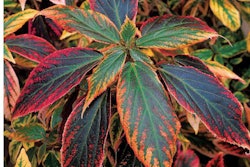 Redhead coleus (Solenostemon hybrida) is a recent introduction that lasts all season.
Redhead coleus (Solenostemon hybrida) is a recent introduction that lasts all season.
New choices that meet the needs now—and in the future. These top picks among plant offerings will enhance your reputation as an expert in sustainable landscape practices.
Buzzwords you’ll hear more and more regarding plant choices: low-maintenance, downsizing, drought-tolerant and edible landscape. We interviewed leading growers and landscape pros to gather top picks among new plant offerings you can use to update your designs and bedding selections and enhance your reputation as an expert in smart investment and sustainable landscape practices.
Low-maintenance plantings
The biggest trend in plantings is not necessarily new, but it’s definitely what clients in both private and commercial settings want. “Clients are asking for low-maintenance landscaping,” says Patrick Beam, a landscape architect and owner of 9th Avenue Designs in Cleveland, Ohio.
“People want plants that don’t require deadheading, special fertilizing and pruning.”
Clients are also seeking more longevity from plantings. “Color has to last longer,” says Jeff Gibson, landscape business manager with Ball Horticultural Company. “The numbers of turns are down at the commercial level. We used to see early spring, summer, fall and sometimes winter. But now your color may have to last from May to September or from October through spring.”
Annuals with staying power are in demand. Redhead coleus (Solenostemon hybrida) is a good example of a recent introduction that lasts all season, performs in sun or shade and has a strong punch of color. Angelonia (Angelonia angustifolia ‘Serena Blue’ or ‘Archangel Raspberry’) is another new low-care performer that tolerates heat, drought and a wide range of conditions, with big, bright blooms that thrive all season.
New sizes You don’t always have room to plant an oak with a 50-foot spread. “One of the overlying trends we’re seeing is that ‘small is good,’” says Jonathan Pedersen, marketing manager with Bailey Nurseries in St. Paul, Minnesota. “For example, it’s cheaper for developers to fit more homes per acre, resulting in smaller yards. The plant material has to shrink, too.”
Archangel RaspberryOld favorites such as hydrangea, which can overwhelm a space, don’t work in compact yards, so smaller varieties are booming in popularity. Accordingly, shrub introductions this year include Little Lime Hydrangea (Hydrangea paniculata ‘Jane’ PPAF), about a third the size of the original hydrangea, with lime-green flowers that turn to pink. Miniature versions of other standbys include Lo & Behold Blue Chip Butterfly Bush (Buddleia x ‘Blue Chip’ PP19991), which is just 2 to 3 feet wide and tall.
New shapes Columnar varieties of trees are becoming increasingly popular, as well, because they have a narrow spread that fits almost anywhere. Belle Tower Sugar Maple (Acer saccharum ‘Reba’) spreads just 18 feet (most sugar maples spread 40 to 50 feet). Newly discovered trees such as Prairie Sentinel Hackberry (Celtis occidentailis ‘JFS-KSU1’), are narrow, super-tough in many conditions, and heat, drought and cold tolerant.
Lo and Behold Blue ChipColumnar trees also provide striking sculptural accents in a landscape, reflecting a movement toward a cleaner look in garden design. Varieties such as Tiny Tower Italian Cypress (Cupressus sempervirens ‘Monshel’ PP12933 Tiny Tower) maintain their neat 3-foot-wide forms without pruning. Blue Arrow Juniper (Juniperus virginiana ‘Blue Arrow’ COPF) has similar attributes for colder climates, boasting blue foliage with a tidy 2-foot-wide spread.
Growers have stepped up their offerings of small trees for use in tight areas next to sidewalks and under utility lines. Examples include Autumn Brilliance Serviceberry (Amelanchier x grandiflora ‘Autumn Brilliance’), a fast grower that attains a height of 20 feet and a spread of 15 feet.
Compact flowering trees with a sturdier habit, such as Royal Raindrops Crabapple (Malus ‘JFS-KW5’ PP 14375), provide a better shape and balanced canopy, coupled with a pop of spring bloom, purple foliage and fall color.
Improved hardiness Water-wise plants will continue to grow in popularity. “We’re developing stock for heat and drought resistance because of dwindling water sources and the fact that irrigation is expensive to install and maintain,” Buley says. Examples of this are the new heat-resistant Flashfire Maple (Acer saccharum ‘JFS-Caddo2’), which has a vibrant fall show, or Redpointe Maple (Acer rubrum ‘Frank Jr.’PP 16769), a vigorous heat-resistant red maple with good branch angles that don’t require a lot of pruning to attain a nice shape.
Native and indigenous plants get a lot of buzz, but they may not always be your best choice. “If you’re looking for a plant that’s drought tolerant and it’s a native, that’s great. But sometimes a non-native works better,” says Kathy Rudnyk, specialty accounts manager with Monrovia. “In California, for example, many natives go dormant in hot weather, so we have to use non-natives for color.”
Hybridizing specimens takes the best traits of a native and combines it with another cultivar to improve attributes such as bloom times and color. For instance, many salvias shut down when it’s hot; the new Heatwave Salvia Series (Salvia greggi) is heat-tolerant, has a longer bloom time and is a tidier plant with richer colors. Other perennials such as coneflower also fit the bill for hardiness and improved color and form. New compact types include Lilliput Coneflower (Echinacea purpurea ‘Lilliput’ PP 18841) and Pixie Meadowbrite Coneflower (Echinacea ‘CBG Cone 2’ PP18546), which attain heights of 8 to 20 inches.
EdiblesEdibles are slowly catching on as elements to add to ornamental landscape. “Blueberry bushes are a good example. They have great fall color, and if you get to the fruit before the birds do, it’s a bonus,” Beam says. “After all, you’re not getting anything off English ivy.” A good variety is Bountiful Blue (Vaccinium corymbosum ‘FLX-2’ PP 19381), which has pretty blue foliage, plentiful berries the first year and a nice compact form of 3 to 4 feet tall and wide.
Figs are also gaining interest, including new varieties such as Celestial Fig (Ficus carica ‘Celestial’). Another new edible this year for warm climates is Angel Red Pomegranate (Punica granatum ‘Smith’ PP 16578 Angel Red). Pretty orange-red flowers and bright red fruit make this a unique — and delicious — addition to the landscape.











